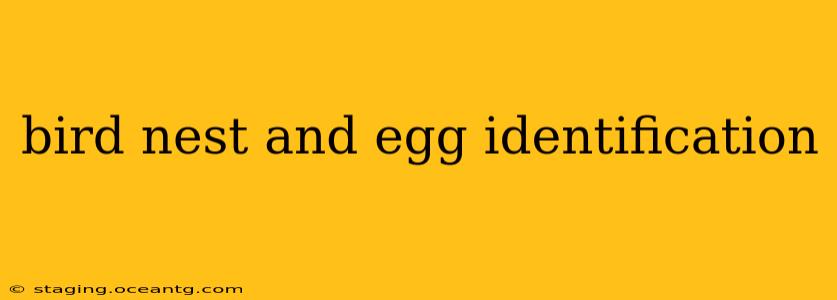Identifying bird nests and eggs can be a fascinating hobby, connecting you with the intricate world of avian life. However, it's crucial to approach this activity responsibly, prioritizing the birds' well-being and avoiding disturbance to their nests. This guide will equip you with the knowledge and tools to identify bird nests and eggs safely and effectively.
What are the common types of bird nests?
Bird nests exhibit remarkable diversity, reflecting the species' adaptations and environments. Some common types include:
- Cup nests: These are the most common type, shaped like a cup and often made of twigs, leaves, grass, and mud. Many songbirds, such as robins and cardinals, construct cup nests.
- Platform nests: Larger birds like eagles, hawks, and ospreys build these sturdy nests on elevated platforms, using large sticks and other materials. These nests can be reused year after year, becoming quite substantial over time.
- Cavity nests: Some birds, like woodpeckers and owls, excavate their nests in tree cavities, while others utilize existing holes in trees or structures. These nests offer protection from predators and weather.
- Pendant nests: These hanging nests, often woven from plant fibers and other materials, are found in species like orioles and weaverbirds. Their intricate design offers both protection and stability.
- Scrape nests: Simpler than other nest types, scrape nests are shallow depressions in the ground, often lined with minimal materials. Ground-nesting birds like killdeer and plovers utilize this type of nest.
How can I identify bird eggs?
Egg identification requires careful observation and consideration of various factors. Key characteristics to examine include:
- Shape: Eggs can be oval, round, pointed, or even elongated.
- Size: Egg size varies considerably depending on the bird species.
- Color: Egg color ranges from white to various shades of blue, green, brown, and speckled patterns.
- Markings: Many eggs feature unique markings, including spots, streaks, or blotches.
- Shell texture: The shell texture can be smooth, rough, or even glossy.
It's crucial to remember that the appearance of eggs can vary even within the same species, influenced by factors like diet and genetics. A field guide with detailed illustrations and descriptions is an invaluable tool for accurate identification.
What are the best resources for identifying bird nests and eggs?
Several excellent resources can aid in your bird nest and egg identification journey:
- Field guides: Regional field guides often include detailed illustrations and descriptions of bird nests and eggs, alongside adult bird descriptions.
- Online databases: Websites and online databases offer photographic guides and information on various bird species, including their nests and eggs. Be cautious and only use reputable sources.
- Local bird clubs and organizations: These organizations are an invaluable source of information and often offer workshops or guided bird walks that can help improve your identification skills.
How can I tell the difference between a robin's nest and a cardinal's nest?
While both robins and cardinals build cup nests, there are subtle differences. Robin's nests tend to be constructed from mud and grass, often lined with finer materials. They are typically built in low shrubs or on window ledges. Cardinal nests are usually placed higher in bushes or trees, and constructed from twigs and grasses, often with a more delicate and less substantial appearance than a robin's nest.
Is it safe to touch bird nests or eggs?
Absolutely not. Disturbing a bird's nest or eggs can lead to nest abandonment, stress on the parents, and even the death of the young birds. Observe bird nests and eggs from a distance, using binoculars if needed. Never touch or handle them. Your safety is also a concern; some birds will aggressively defend their nests.
How can I tell if a bird's nest is active?
Look for signs of recent activity such as:
- The presence of adult birds: Observing parents tending the nest is a clear indication of an active nest.
- Fresh droppings near the nest: The presence of droppings suggests recent activity.
- Incubation: If the eggs are being incubated, you might observe an adult bird sitting on the nest for extended periods.
Remember, responsible and ethical observation is key to appreciating the wonders of bird nests and eggs without harming the birds or their environment. Enjoy the fascinating world of avian nesting!
